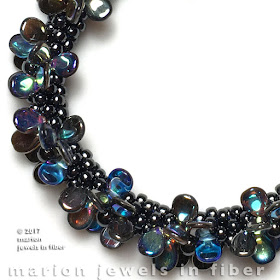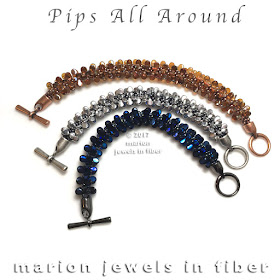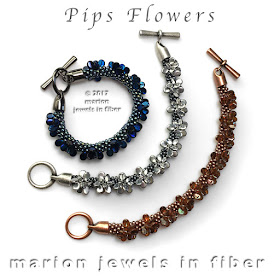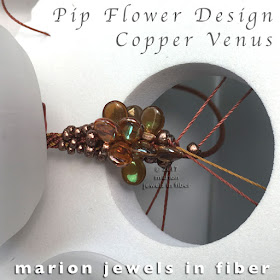I bought some Preciosa PIP Beads a while ago... and thought they would be perfect for kumihimo. I decided to play around with them and to do a quick project... Many bracelets later, I have now 4 design variations, a 25 page manual with all the steps, the beads sequences for each variation, the bracelet length versus wrist size, and bead numbers charts, all broken down in easy to follow steps with over 50 clear and easy to understand pictures and charts.
How did this happen?
While working on this project, I fell in love with the PIP beads. They are shaped like small petals and perfectly suited for kumihimo. They lend themselves to flower designs and to dimensional geometrical designs.
Here is what I learned along the way...
PIPS All Around - Design 1
My first design, very dimensional, sculptural and geometrical, has a simple bead placement with Preciosa PIPs and Miyuki 8s.Choices
While making these, I experimented using the standard C-Lon Bead Cord and C-Lon Fine Weight Bead Cord. The result is the same, even I cannot tell which one was done with which cord, but the Fine Weight is a lot easier to work with. The beads slide up and down the cord more freely. And since I add a central cord at the braid center for my bracelets, the C-Lon Fine Weight Bead Cord with a 24 lb breaking strength is plenty strong enough. So that's settled, Fine Weight is the way to go.
Then of course there is the choice of central cord size, I played around a bit and the 1 mm Nylon Satin Cord works well. It does not add bulk to the bracelet, and it keeps the bracelet nice and flexible.
Next I decided to try a bracelet with a smaller flatter profile. The PIP All Around is round...
Half Round PIP Design - Design 2
So I designed one with PIPs (mixed with 8s) on one side and 8s on the other side. That required careful notes, charts to keep track of the bead pattern and ultimately the creation of a system to keep track of the bead sequences. I ended up coming up with a great way using spreadsheets and charts. It makes following bead patterns very simple and easy.The bracelet is very modern, with a lower profile than the first design... It is half round.
At this point, I was really intrigued, I had developed a system to keep track of the bead placement and sequences, and I really wanted to make something with a flower design with kumihimo... So more experimentation and later... The result...
PIP Flowers - Design 3
Flowers like little cluster of petals placed at regular intervals on the beaded braid. So yes, now I was pretty happy, I had three design variations in three colors. I did a demo at an art center and everyone loved the bracelets. Lots of woman wanted to buy one, but they are samples not for sale... So next - time to write the manual.By the time I write a manual, I have already made the piece that will be in the tutorial many times. The process by then has been refined, all the production kinks are already out of the way. And while making the piece to be featured, I stop to take pictures and I write down the steps one by one. When that's done, I start over again and make another bracelet, but this time I simply follow the directions I wrote, and edit as I go. The goal is to make sure everyone can follow the steps.
This is not the way I used to write tutorials years ago. I have learned that doing it this way will save us lots of time in the long run. Less hassles for you, less questions, less emails for me to respond to...
So yes, I was all done ready for the final steps, an outside editor and the kit assembly... To assemble kits, cords have to be cut, beads measured and counted, clasp added, then it gets packaged and labeled. But late at night...
Duo PIP Flower Design - Design 4
I decided to experiment once again with a new version of the flower design with a center bead and dual coated PIP beads, PIPs with one color on one side and another on the other side.So yes, the next design challenge, figuring out how to load the dual sided PIPs onto the cord to get them to face the right way... More charts, more spreadsheets, another addition to the tutorial, and three additional colors. I am finally done!
The flowers alternate, one with the transparent colored side up, the next with the metallic coated side facing us, and the flower has a bead at the center of each flower design.
Color Choices
And the colors with the dual sided PIPs...
You can find out more about this project HERE and if you interested in making these bracelets without having to spend the time experimenting, undoing and redoing... The 25 page manual, the kits with all the cord & beads, and tool bags are available at Marion Jewels in Fiber online store.
I thought it would be nice to write about the process of creating a kit and a tutorial... and I could go on. I could speak about how the braid starts and endings evolved. The new way presented in this kit, not seen elsewhere, is so much easier and simpler than my early attempts. Simple and elegant seem simple, right, but that's when someone else has already done it and shows the way. Otherwise it is often only found after a long search. Simplifying is harder than it looks... You might have to get a kit or manual to understand what I am talking about. -Marion ;))
Oh, and read my next post comparing kumihimo to other beading techniques... It has newer pictures of the PIP bracelets.
I thought it would be nice to write about the process of creating a kit and a tutorial... and I could go on. I could speak about how the braid starts and endings evolved. The new way presented in this kit, not seen elsewhere, is so much easier and simpler than my early attempts. Simple and elegant seem simple, right, but that's when someone else has already done it and shows the way. Otherwise it is often only found after a long search. Simplifying is harder than it looks... You might have to get a kit or manual to understand what I am talking about. -Marion ;))
Oh, and read my next post comparing kumihimo to other beading techniques... It has newer pictures of the PIP bracelets.















No comments:
Post a Comment